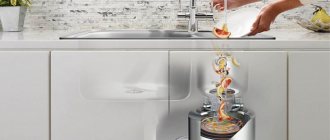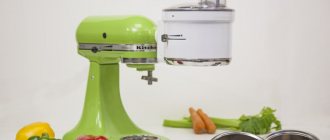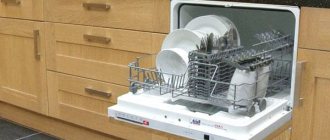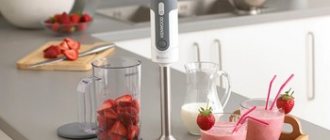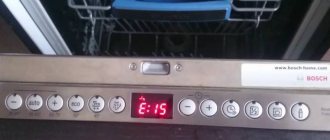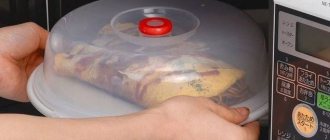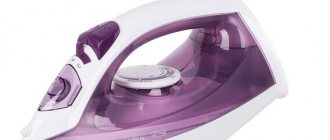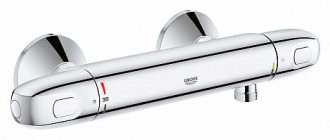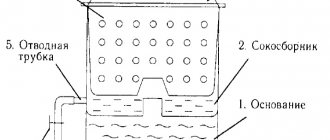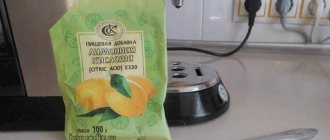A disposer is a shredder of household organic waste and food debris installed directly under the kitchen sink.
Its purpose is to transform food waste into a mass, which, when washed off with water, easily goes down the drain.
Such a kitchen shredder will help people who are concerned about the problem of separate waste collection, because the question of where to put food waste will lose its relevance.
What it is?
Most people collect food scraps in buckets before washing dishes and then start washing.
The Disposer is designed to eliminate this operation in the kitchen. With its use, the need for waste buckets and scraping leftover food from plates disappears.
Before using the disposer, meshes were installed in sinks to prevent waste from entering the drain.
Now the mesh is removed completely and everything is done to ensure the best penetration of food debris into the sewer system.
In essence, the action of a kitchen disposer resembles a meat grinder through which food remains are passed , turning into a paste-like mass that is easily washed off with water. The device is installed directly under the sink and integrated into the drainage system.
How does a food chopper work?
A standard dispenser is a cylindrical metal or plastic device, the inside of which is equipped with a crushing disk and cutting surfaces. The grinding elements of the unit are made of high-quality stainless steel, since it is operated in water. The food chopper is installed in the sewer system under the sink. Food waste enters the unit through the drain hole in the sink.
When the device is connected to power, the crushing disk starts. At this point you can start filling the disposer chamber. A rotating disk forces particles to move along walls equipped with a jagged surface. This treatment allows you to quickly grind food into fractions up to 3 mm in size, after which the waste is discharged into the sewer through special holes in the disposer body. The end of the procedure is accompanied by the characteristic sound of the engine idling. After this, you need to turn off the power to the device and flush the drain with high pressure water for 10–15 seconds.
What kind of waste does a kitchen recycler process?
Shredder manufacturers recommend using disposers for almost all waste , including:
- fruits and vegetables;
- rinds of watermelons, melons, pumpkins;
- chicken and fish bones;
- any cereals, bakery and pasta products;
- shells of all types of nuts;
- napkins and cigarette butts.
There is a long list of items that should not be thrown down the drain in hopes of being shredded in a disposer.
First of all, these are different:
- films;
- plastics;
- fabrics;
- rubber and metal products;
- products with long fibers or strands;
- hair.
Disposing of the listed materials into the disposer will result in equipment failure.
As a rule, all disposers are equipped with a locking system. This means that if a foreign object or too hard bone gets into it, a system is activated that turns off the device.
What is a sink food waste disposer
This household appliance serves to grind waste that enters the sink, thereby making it easier for it to pass through the drain pipe. It is mounted at the outlet of the sink and operates from the mains. The main advantages of a food waste disposer for the sink are ease of operation and long service life (approximately 15 years). Below we will take a closer look at the operating principle of the device and the features of its installation.
A food waste disposer is installed at the outlet of the kitchen sink.
Working principle of a sink grinder
The food waste grinder (disposer) is a durable metal body of a cylindrical shape, inside of which there is a crushing disk. The disk rotates using an electric motor located at the bottom of the housing. Taking into account the environment in which the device has to operate, the disk is made of stainless steel, which is characterized by increased resistance to corrosion. This means that the sink waste disposer is not afraid of any aggressive substances that may be encountered in the kitchen.
For safe and long-term use of the shredder, place in it only those wastes that are specified in the operating rules
The process of shredding waste is very simple. They enter the chamber of the device through the drain hole of the sink, and then, under the influence of the centrifugal force of the disk, they are pressed against the walls of the cylinder and ground. For grinding, a special stationary grater is used, mounted on the inner walls of the device. From the shredder chamber, the waste flows directly into the sewer through the drain pipe.
Helpful advice! Do not be afraid that a fork or spoon caught in the drain hole will break the device. The shredder is designed in such a way that if a solid object hits it, the engine automatically turns off.
Design of a food waste shredder
Not only the usual push-button switch can serve as a switch, but also the chopper cover, which you simply need to turn to turn on the device.
How to use a chopper
Using a sink grinder is very simple, but for maximum efficiency and long-lasting operation, it is recommended to follow the following procedure:
- turn on the water;
- turn on the waste shredder;
- direct waste into the sink drain;
- turn off the shredder after its operation is completed, when the noise of the shredded waste subsides;
- After a short period of time, turn off the water.
The crushed waste along with the water flow is removed into the sewer system
There are also a number of things you shouldn't do to your shredder if you want it to last as long as possible. This mainly concerns items that cannot be thrown into the disposer:
- Metal, glass and plastic. They simply cannot be shredded, so avoid getting them down the drain.
- Plastic bags and other packaging containers. This also includes products made from rubber and other plastic materials that are difficult to grind. They do not grind properly and can clog the drain pipe.
- Threads, ropes and hair. These materials can easily wrap around the motor shaft and cause premature failure.
The socket for connecting the disposer must be grounded and equipped with moisture protection
How to choose a sink disposer? We will talk about this further.
Features of choosing a chopper
One of the main characteristics that you should pay attention to when choosing a kitchen sink grinder is the engine power. Not only the price of the device, but also its efficiency directly depends on this parameter. The size of the case is also of great importance. The larger it is, the greater the amount of waste passes through it per unit of time. Some models may have additional features, the presence of which is also worth paying attention to when choosing a disposer.
The button to turn on the chopper is built into the countertop next to the kitchen sink
Helpful advice! If you want to avoid the spread of unpleasant odors from the sink drain hole and prevent the growth of bacteria, then you should pay attention to disposers with a special antibacterial coating inside the body.
If you are planning to buy a food waste disposer for your sink, you should pay attention to the number of modes when choosing a model. Some of them involve several operating speeds for the most efficient grinding of waste of varying degrees of density.
Functional drawers with a hole in the middle leave space for a sink equipped with a food waste disposer
By the way, many modern manufacturers also produce models with different numbers of attachments. This significantly expands the range of waste that can be crushed using the device.
The ideal option for a food waste shredder for the sink, which you can buy for your home, is a model with increased noise insulation, built-in automatic overload protection, a reverse rotation function and a special antibacterial coating inside.
For free movement of food waste into the sewer system, when connecting the disposer, use pipes with smooth walls
Types and principle of operation
Next, we will describe the operating principle of a food waste shredder and a food destroyer for the sink, or, as it is also called, a disposer.
The vast majority of disposer models are equipped with an electric drive . But mechanical models that operate under the influence of water pressure are also used.
How do mechanical models work?
For successful operation of mechanical shredders, a water pressure of at least 4 bar is required. With a normally functioning plumbing system, this is the actual water pressure in the tap.
But the pressure indicator does not depend on the residents; a decrease in water pressure is especially often observed on the upper floors of houses.
Of course, the shredder will have no effect if the water pressure in the tap is low.
Electric shredders
Electric kitchen dispensers are in greatest demand.
The dispenser equipped with an electric drive does not depend on the water pressure in the tap . It just needs to be launched by pressing a button.
Batch loading models load waste first. With continuous loading, the shredder is started first, and then waste is placed into it for shredding.
There are also automatic models that do not require pressing a button, but turn on when waste gets into them.
Kinds
Depending on the principle of operation of the device, electric and hydraulic disposers are distinguished. The former operate from the network, the latter - under the influence of strong water pressure. Each option has its pros and cons, which are taken into account by the housewife when purchasing. Also, the choice of one or another type of device is influenced by the features of the communication systems in the room.
Electric disposer
This type of shredder is simple and easy to use. The disadvantage of such a device is the inability to effectively deal with large and dense food waste. Electric disposers are conventionally divided into 2 types:
- With continuous loading. Such a system involves a constant supply of waste into the chamber of the unit connected to the network. The device works all the time while the owner occupies the sink. The device is turned off after washing dishes.
- With portion loading. The disposer is connected to the network after the waste is placed in the chamber. At the end of processing, the unit must be de-energized. If necessary, the cycle is repeated. Such devices are not very convenient to use, and therefore are not very popular among housewives.
Hydraulic disposer
This type of grinder starts working under the influence of strong water pressure. The hydraulic disposer chamber is equipped with special stainless steel knives. As water enters, they begin to rotate and grind the food waste that gets inside. Such devices are considered more economical - they do not require electricity to operate.
In connection with this fact, greater safety during operation can also be noted. The internal equipment allows you to grind large and coarse fractions that electric analogues cannot handle. The hydraulic device operates silently.
The presence of the above advantages determines the higher cost of this type of product. However, despite all the positive qualities, using a hydraulic disposer may not be possible without sufficient water pressure. In homes where there are problems with pressure in the pipes, such a device may be useless. In this case, the only option is an electric shredder.
Selection criteria and safety
The selection criteria for modern models are based on ease of use and cost of equipment.
In addition, it is worth paying attention to a number of indicators :
- chopper power;
- rotational speed;
- anti-corrosion coating;
- launch type;
- presence of reverse;
- availability of a repair service nearby;
- availability of consumables and spare parts;
- equipment noise during operation;
- lifetime.
A very important point - the disposer is considered an absolutely safe device ; any model is installed so that the cutting working parts of the equipment are inaccessible during operation.
Other nuances when choosing
When looking at different models of disposers, you should first of all pay attention to the engine power. The larger the parameter, the more efficient the device will work. However, this indicator directly affects the price of the product. You should also pay attention to the size of the receiving chamber. The larger the disposer capacity, the more waste it processes per unit of time.
When selecting products, you need to remember the size of the drain in the sink. The discrepancy between this parameter and the diameter of the disposer inlet is accompanied by difficulties during installation.
Many models have several modes that are designed to process waste of different densities. When purchasing, a housewife should consider which products she most often deals with and choose an appliance based on this factor.
If possible, preference should be given to those with an antibacterial coating on the body - this will effectively avoid unpleasant odors from the drain.
Is a disposer really necessary?
The introduction of disposers into the everyday life of every family is not yet supported at the state level. The reason is that authorities fear a significant increase in the load on sewerage and treatment systems.
The authorities of large American cities experienced similar doubts half a century ago. They conducted an experiment on the use of disposers in order to determine the consequences on sewer systems.
The result was surprisingly favorable:
- water consumption increased slightly, which did not have any negative impact;
- the energy consumption for operating the disposer turned out to be comparable to using one additional light bulb;
- The problem of accumulation of wastewater saturated with biological waste was solved by installing digesters for biogas production.
The conclusion that the Americans came to is that the use of disposers not only does not have a negative impact , but can also bring direct economic and environmental benefits.
The American Ministry of Health recommended installing disposers in all houses under construction; today more than half of the kitchens of American houses are equipped with this device.
Benefits of use
Garbage reform today is at least puzzling due to its ill-conceived nature.
Russians, in principle, are not against separate waste collection, but do not see any practical sense in this idea of the authorities.
The waste recycling system is not debugged and not thought through to its logical conclusion.
Perhaps reform ideas were calculated by people who had never washed dishes or cooked food.
Because the biggest difficulty of separate collection lies precisely in separating food products from other solid waste.
Biodegradable food scraps account for approximately 30% of all waste.
If these unused products go down the drain and are then turned into biogas , then the problem of waste separation will be practically solved. At least for big cities and the capital.
It's not at all difficult to put paper and plastic in separate bags, because the main problem - leftover food - goes down the drain.
To be completely honest, it is unlikely that anyone will reach into a garbage bag to sort through its contents again if they accidentally threw leftover food into it.
Positive consequences of using disposers in Moscow apartments:
- about 2.5 million tons of food waste annually will be processed into biogas at mini-thermal power plants;
- the amount of waste disposed of in landfills will be reduced by the same amount;
- processed waste in the form of biogas will be used for heating and electricity generation;
- in addition to gas, food scraps can be processed into high-quality fertile soil and a number of other necessary goods and products;
- the use of household shredders will simply make life easier for millions of housewives in Moscow and other large cities.
The negative side of the issue is the price of disposers. Still, the cost of one device from 10 thousand rubles is expensive for most people.
To quickly introduce disposers into the everyday life of every person, it is necessary to radically reduce the price of the product and organize installation and repair services.
You can use the disposer in an apartment, private house, or country house.
The device is not in demand only in the case of using household food waste in a subsidiary farm - for pet food, for the production of biofertilizers, or if there are other alternative options for getting rid of kitchen food scraps.
